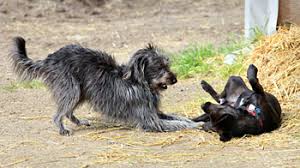Pain related Dog Behaviour
Adrian Kollnberger • Nov 18, 2021
Pain related Aggression in Dogs
Over the years of dealing with multiple behavioural issues involving aggression has taught me that when a normally friendly, sociable dog displays aggression in certain situations this is quite often pain related. For example, small dogs who snarl and snap when they anticipate being picked up are often labelled as being “brats” or “spoiled” when they are actually suffering from undiagnosed spinal pain. Often the behaviour will vanish or vastly reduce in frequency and intensity after the dog receives medication for pain”. The following is an article which I have "borrowed" from The Whole Dog Journal which is based on a study conducted by an eminent Veterinarian, Daniel Mills . The study and article explain the connection between pain and dog behaviour.
Dr. Mills is passionate about raising awareness of the importance of recognising and treating pain in behaviour cases – so much so that he has collaborated with other researchers and behaviourists to publish a framework for thinking about these cases, along with a case series of examples from his and others’ practices.
Mills describes a number of cases sharing a recurring theme: The initial veterinary consult reports the physical exam, blood work, and possibly even radio graphs as “unremarkable.” Yet a subsequent exam with a veterinarian considering pain as a possible cause turns up something suggestive – perhaps an awkward gait, an uneven weight distribution suggesting the dog is shifting weight off one leg, or the owner reveals under more pointed questioning that the dog has been reluctant to go for walks recently. Often, an old injury that was thought to be resolved is mentioned. Further testing finds a likely cause of pain – or, sometimes, not. But either way, a trial of analgesics results in return to normal behaviour.
Mills’ framework divides pain-related behaviour cases into four categories:
• Unwanted behaviour directly caused by pain.
• Pain causing secondary behavioural issues in addition to existing ones.
• Unwanted behaviour exacerbated by pain.
• Behaviours that may not be problematic to owners, but are actually signs of pain.
• Unwanted behaviour caused by pain.
Veterinarians are trained to recognise certain behaviour changes as indicative of pain, such as decreases in normal activity, licking the affected area, changes in gait, repeated shifting of weight while standing, and the most obvious of all, a flinch or yelp when the area is touched.
Vets are less likely, however, to recognise some of the more unusual manifestations of pain, such as star gazing (staring at the ceiling or sky) or compulsive disorders, which can be indicative of gastrointestinal [GI]distress; pica (compulsive eating of non-food objects), which may be related to musculoskeletal pain in addition to the more obvious GI link; hypersensitivity to heat or cold; increased clinginess and seeking of attention from the owner; as well as behaviours more commonly considered problematic, such as fear, anxiety, aggression, resource guarding, or destruction of household items when left alone.
In fact, differences between presentations of aggression can point veterinarians to suspicion of a pain component. In the cases described by Dr. Mills, dogs with pain-based aggression are often described as Jekyll and Hyde-like, with unexpected and sudden behaviour changes. Pain-based aggression appears to occur more commonly when dogs are approached by a person, particularly when they are lying down. These dogs are more likely to bite a limb than any other part of the body, and their aggression is briefer and easier to interrupt.
Behavioural changes caused by pain may be more subtle than outright aggression. Dogs performing at a high level in work or sports may begin to show degraded performance that doesn’t have a clear cause, but resolves when pain is identified and addressed.
While pain may certainly prevent a dog from reaching his full athletic potential, it can also have more psychological effects, such as making learning more difficult. The dog may appear to be less able to absorb training; imagine trying to listen to a challenging lecture with a splitting headache.
• Pain causing secondary behavioural issues in addition to existing ones.
Behaviour cases can be quite complex, and full resolution is not always reached. The owner may feel that they have hit a wall and that progress has stopped; relapses are common and frustrating. In some cases, those final steps may be elusive because of an unrecognised pain component.
Initially, picking apart which behaviours are due to pain and which are due to other triggers may be nearly impossible. However, as some unwanted behaviours are resolved through treatment of a behavioural diagnosis, while others begin to appear intractable, the relevance of pain may be revealed.
In one such case, a Border Collie with separation anxiety was destructive when left alone, digging through carpet and door frames. While his anxiety appeared to improve with anti-anxiety medication and behavioural modification, his digging did not. Pain in a hind leg, redirected to nearly compulsive digging with his front legs, was resolved with medication, and the digging stopped.
In this case, the digging initially appeared to be part of the dog’s separation anxiety, and as a result, difficulty in resolving the digging was initially assumed to indicate that the anxiety had not resolved. In fact, the two problems were separate.
• Unwanted behaviour exacerbated by pain.
In more straightforward cases, pain does not actually cause unwanted behaviour, but instead worsens existing behaviour problems.
The relationship between pain and behaviour is bidirectional; stress in the form of frustration, fear, or anxiety can cause a negative outlook that increases the perception of pain, while pain can itself increase stress. In fact, tensing from anxiety can directly exacerbate musculoskeletal pain. Who hasn’t snapped at a co-worker or spouse when dealing with a headache or other chronic pain?
These cases will often present with behaviour that appears out of proportion to its cause. An animal’s responses may be excessively intense, or the dog may generalise more quickly and widely than otherwise expected.
For example, a noise-sensitive dog may be startled by a loud noise in one location and then rapidly generalise to avoiding a wide area (perhaps even miles) around the original source. Such over-generalisation may provide a hint that there’s more going on than simply a learned association with the original startle resulting in sound sensitivity.
Impressive reduction of reactivity may be achieved in such cases with regular pain medication or other measures to reduce pain, like appropriate physiotherapy, even if the root of the anxiety remains.
• Behaviours that may not be problematic to owners but that indicate pain.
As we care for animals who cannot verbalise their inner states to us, it is incumbent on us to be alert to signs of pain, even when those signs do not present a problem for us.
It is easy for us to normalise behaviour that is in fact not healthy, such as the laboured breathing of a flat-faced dog, repetitive scratching of the neck which might suggest syringomyelia (a cyst within the spinal cord), head shaking indicative of an ear infection, or just an unusual sitting position in a dog who cannot hold his legs or back normally, perhaps secondary to obesity or a spinal malformation.
HELPING YOUR DOG
Veterinarians may not be alert to these multi-factorial problems. Indeed, Dr. Mills confides that despite being an established veterinary behaviour expert and leading academic in the field, he still struggles to convince some vets (those in general practice and also specialists in relevant disciplines like orthopaedics) about the significance of this issue. Presented with a behavioural issue, they may reach for a behavioural solution. While a veterinarian may consider pain, given a normal physical exam and other testing, he may not pursue a trial of analgesics or even more conservative pain management measures. Addressing pain is often seen as an avenue of last resort, when nothing else resolves the primary problem. Mills argues that pain should be addressed first, not last.
Moreover, if pain is a reasonable possibility but no cause is apparent on physical exam or testing, Mills typically recommends a trial course of analgesics. Many documented behaviour cases have shown significant improvements or even resolution when treated with pain medication.
If the first analgesia trial does not provide results, it is appropriate to try another type of analgesic with a different mechanism of action, in case the first was not right for that dog’s particular issue. Mills argues that the risk of side effects can be minimised and that the benefits of using pain medication will normally outweigh the risks, but it is important that any trial is done under veterinary supervision as over-the-counter medications for humans can be quite toxic to dogs.
TAKE THE LEAD
If you suspect your dog may have a behavioural issue rooted in or exacerbated by pain, advocate for her. Encourage your veterinarian to investigate possible causes of pain. Suggest trialling a course of analgesics, and keep a diary to report behavioural changes.
If your veterinarian does not feel such an approach is appropriate in general, emphasise that your dog’s behaviour is not normal for her. You may need to do some of your own detective work to present some possible causes to your veterinarian. A copy of Mills’ paper is below, so you can give a copy to your veterinarian.
If you do find that you’re dealing with a case of pain-related behaviour, encourage your veterinarian to contact Mills. His work is ongoing, and he hopes that he can bring veterinary behaviourists together with the wider veterinary community to build momentum on recognising the importance of identifying and treating pain in behaviour cases. He continues to collect case histories for this work.
Mills notes, “Dogs work incredibly hard to fit in, and if they don’t, we need to ask why.” As a society, we are lucky to have access to incredibly effective pain medication – don’t hesitate to consider its use under veterinary guidance when you think your dog might need it.
Contact Us
Thank you for contacting us.
We will get back to you as soon as possible.
We will get back to you as soon as possible.
Oops, there was an error sending your message.
Please try again later.
Please try again later.






